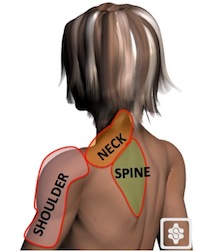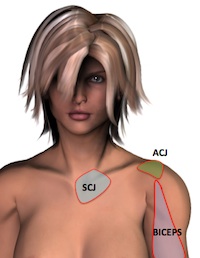Shoulder Pain
 Lennard Funk
Lennard Funk
Pain in the shoulder area can have numerous causes and originate from many structures. The type and distribution of the pain is helpful in determining the origin and cause of the pain.
Types of pain:
- Burning pain = nerve pain
- Aching pain - bones or joints
- Aching after activity = muscular
- Sharp, stabbing pains = structures catching against each other (such as impingement or labral tears)
- Most people think the shoulder is in the area between your neck and top of your arm (see figure 1), however pain from your shoulder is actually felt in the upper arm and can radiate down your arm.
- Pain originating from your neck is usually felt in the area between your shoulder and neck.
- Pain behind your shoulder blade is often either from your thoracic spine or conditions of the shoulder blade

- Specific narrow areas of pain are shown below. These are the acromioclavicular joint (ACJ), sternoclavicular joint (SCJ) and biceps:

Common shoulder pain patterns
From our study published in 2011 (click here) we found the following pain patterns with the common shoulder disorders:
- Sharp pain around front of shoulder and down back of arm
- Dull aching pain radiating to hand anteriorly
- Burning pain anteriorly
- Sharp pain around back of shoulder and down front of arm
- Dull aching pain similar pattern to sharp pain
- Stabbing pain centred over anterior and dorsal shoulder, with no radiation down arm
- Dull aching pain around dorsal aspect
- Sharp, shooting, burning and dull aching pain affecting entire arm, from shoulder to hand


